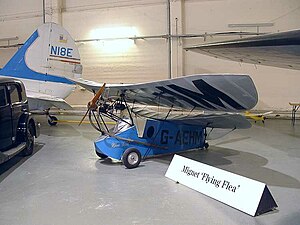Mignet HM.14
| Mignet HM.14 | |
|---|---|
 |
|
| HM.14 at The Science Museum at Wroughton | |
| Role | Single-seat light aircraft |
| Manufacturer | homebuilt aircraft |
| Designer | Henri Mignet |
| First flight | 10 September 1933 |
| Introduction | 1933 |
| Produced | 1933-today |
The Mignet HM.14 Flying Flea (Pou du Ciel literally "Louse of the Sky" in French) is a single-seat light aircraft first flown in 1933, designed for amateur construction. It was the first of a family of aircraft collectively known as Flying Fleas.
The HM.14 was designed by French radio engineer Henri Mignet. It was the result of his ambition to design a safe aeroplane that could be built quickly and cheaply by any amateur familiar with simple woodwork and metalwork skills. It followed a progressive series of designs, of which the HM.8 monoplane was already successful as an amateur-built aircraft. On 10 September 1933, at the Bois de Bouleaux near Soissons, Mignet piloted the first flight of the HM.14. In the following months, he made many flights with progressive modifications to improve its handling and performance, totalling 10 hours test-flying time. He described the HM.14 as his Pou no.4, presumably counting from the HM.11, that featured a large pivoting flap between the fixed front and rear wings. The prototype HM.14 had a wingspan of 6 m (20 ft). It was powered by an Aubier et Dunne 540 cc three-cylinder two-stroke motorcycle engine, producing about 17 hp (13 kW) at 4,000 rpm. The engine was connected to the propeller shaft via a chain drive with a 2.5:1 reduction ratio. Subsequent examples were built with many optional engine and wingspan variations.
In September 1934, the French aeronautical magazine Les Ailes published Mignet's article Le Pou du Ciel, in which he described the HM.14. In November 1934, he published his book Le Sport de l'Air that gave all the dimensioned details of materials, plus descriptions and techniques, to enable readers to construct and fly their own HM.14s without further specialist help. In September 1935, the Air League published an English translation of Le Sport de l'Air, and it was also serialised in the October, November and December 1935 issues of the magazine Newnes' Practical Mechanics.
The HM.14 is most commonly described as a tandem wing aircraft, although the main wing overlaps the rear wing in the basic design, so it almost qualifies as a highly staggered biplane without horizontal tail. Construction of the airframe employs mostly birch plywood sheet, spruce laths, steel tubing, steel cables, proprietary metal fittings and fixings, adhesives, and linen fabric.
...
Wikipedia
